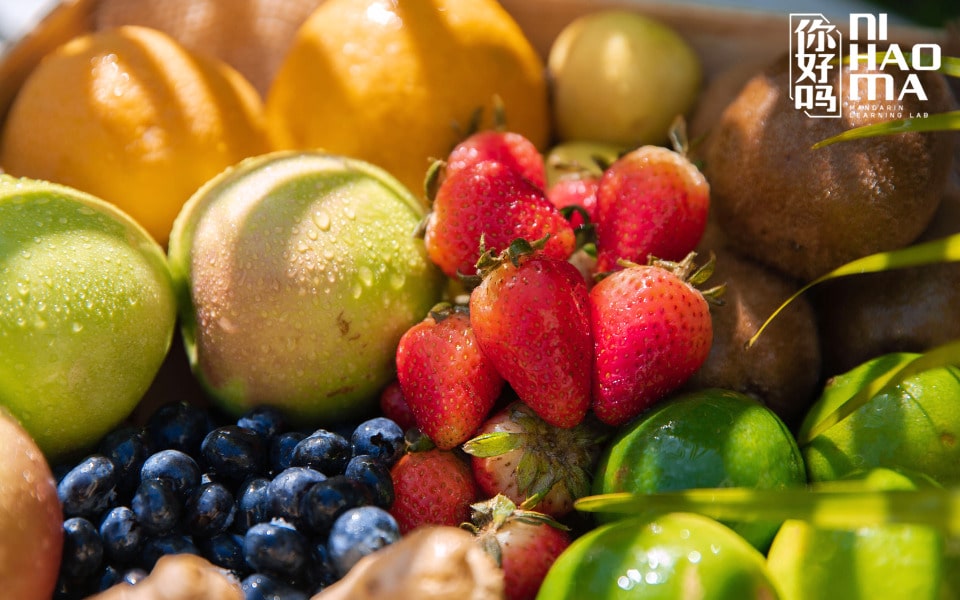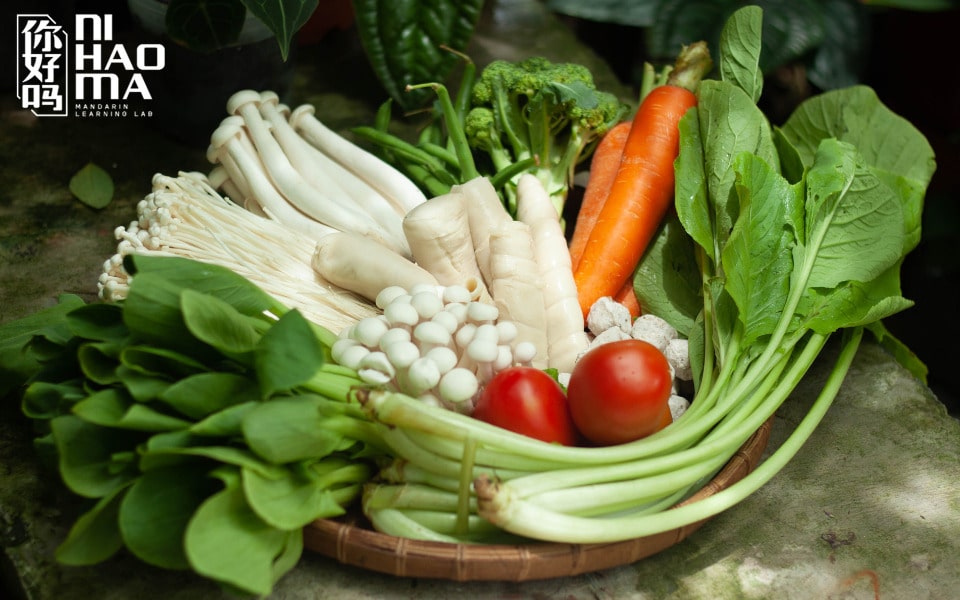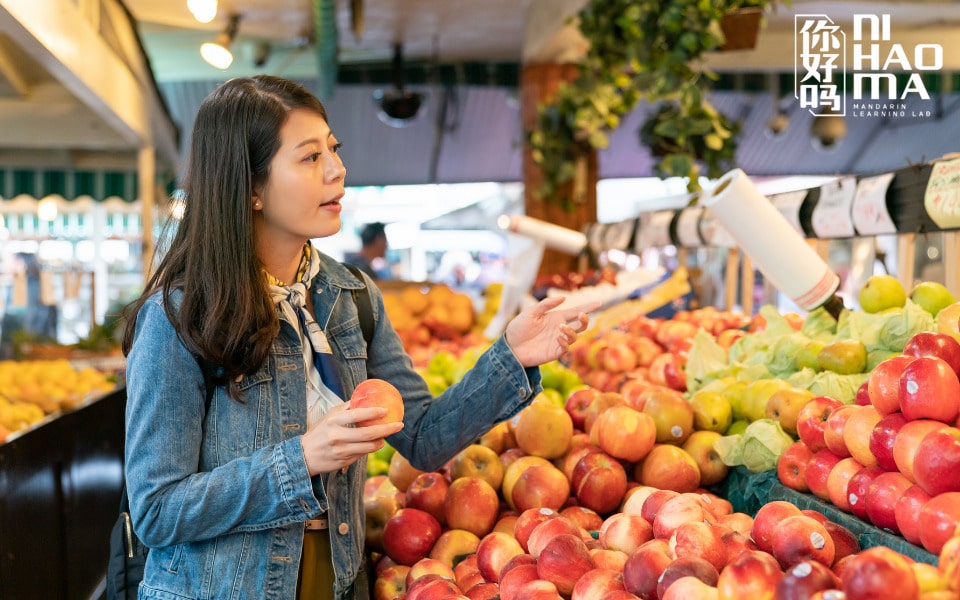Understanding fruits in Chinese vocabulary is essential for everyday communication, especially considering their nutritional importance. This article by Ni Hao Ma will guide you through relevant vocabulary and provide practical conversation examples for immediate application.
Chinese Vocabulary on Fruits
What is the name of “custard apple” in Chinese? And what about “star fruit”? You might be curious to know the names of common fruits in Chinese. The topic of fruits is a fundamental one, and it’s something you can easily encounter when communicating in daily life.

Here, Ni Hao Ma will introduce you to a list of the most common fruit names in Chinese to help you expand your vocabulary for better communication!
| No | Chinese | Pinyin | Meaning |
|---|---|---|---|
| 1 | 芒果 | mángguǒ | Mango |
| 2 | 菠萝 | bōluó | Pineapple |
| 3 | 火龙果 | huǒlóngguǒ | Dragon fruit |
| 4 | 橙子 | chéngzi | Orange |
| 5 | 西瓜 | xīguā | Watermelon |
| 6 | 榴莲 | liúlián | Durian |
| 7 | 龙眼 | lóngyǎn | Longan |
| 8 | 荔枝 | lìzhī | Lychee |
| 9 | 牛油果 | niúyóuguǒ | Avocado |
| 10 | 枇杷 | pípá | Loquat |
| 11 | 葡萄柚 | pútáoyòu | Grapefruit |
| 12 | 杨桃 | yángtáo | Starfruit |
| 13 | 香蕉 | xiāngjiāo | Banana |
| 14 | 苹果 | píngguǒ | Apple |
| 15 | 草莓 | cǎo méi | Strawberry |
| 16 | 百香果 | bǎixiāngguǒ | Passion fruit |
| 17 | 桃子 | táo zi | Peach |
| 18 | 龙眼 | lóngyǎn | Longan |
| 19 | 山竹 | shānzhú | Mangosteen |
| 20 | 莲雾 | liánwù | Rose apple |
| 21 | 李子 | lǐ zi | Plum |
| 22 | 红毛丹 | hóngmáodān | Rambutan |
| 23 | 释迦果 | shìjiā guǒ | Cherimoya |
| 24 | 番荔枝 | fān lìzhī | West Indian cherry |
| 25 | 樱桃 | yīng táo | Cherry |
| 26 | 柚子 | yòuzi | Pomelo |
| 27 | 木瓜 | mùguā | Papaya |
| 28 | 石榴 | shí liú | Pomegranate |
| 29 | 蓝莓 | lán méi | Blueberry |
| 30 | 椰子 | yēzi | Coconut |
| 31 | 覆盆子 | fù pén zi | Raspberry |
| 32 | 葡萄 | pútáo | Grape |
| 33 | 番石榴 | fān shí liú | Guava |
| 34 | 蜜瓜 | mì guā | Melon |
| 35 | 哈密瓜 | hā mì guā | Hami melon |
| 36 | 梨子 | lízi | Pear |
| 37 | 杨梅 | yángméi | Bayberry |
| 38 | 白玉枇杷 | báiyù pípá | Japanese loquat |
| 39 | 人心果 | rén xīn guǒ | Sapodilla |
| 40 | 菠萝蜜 | bō luó mì | Jackfruit |
| 41 | 柿子 | shìzi | Persimmon |
| 42 | 甘蔗 | gānzhè | Sugarcane |
| 43 | 桑葚 | sāngrén | Mulberry |
| 44 | 西印度樱桃 | xī yìndù yīngtáo | Surinam cherry |
| 45 | 牛奶果 | niúnǎi guǒ | Milk fruit |
| 46 | 金酸枣 | jīn suānzǎo | Sour jujube |
| 47 | 豆薯 | dòu shǔ | Taro |
| 48 | 人面子 | rén miànzi | Balsam pear |
| 49 | 奇异果 | qíyìguǒ | Kiwi |
| 50 | 桔子 | júzi | Tangerine |
| 51 | 杏子 | xìngzi | Apricot |
| 52 | 香瓜 | xiāngguā | Cantaloupe |
| 53 | 龙贡果 | lóng gòng guǒ | Longkong |
| 54 | 余甘子 | yú gān zi | Indian gooseberry |
| 55 | 无花果 | wúhuāguǒ | Fig |
| 56 | 酸角 | suān jiǎo | Tamarind |
| 57 | 榅桲 | wēnpó | Medlar |
| 58 | 金桔 | jīnjú | Kumquat |
| 59 | 水果 | shuǐguǒ | Fruit |
| 60 | 加拉苹果 | jiālā píngguǒ | Gala apple |
Common Vegetables in Chinese
In addition to fruits, vegetables are an essential part of our daily diet, providing necessary vitamins, minerals, and fiber for the body. Here’s a summary of some common vegetables in Chinese to help you easily look them up and remember.

| No | Chinese | Pinyin | Meaning |
|---|---|---|---|
| 1 | 胡萝卜 | húluóbo | Carrot |
| 2 | 土豆 | tǔdòu | Potato |
| 3 | 红薯 | hóngshǔ | Sweet potato |
| 4 | 白萝卜 | báiluóbo | Daikon |
| 5 | 南瓜 | nánguā | Pumpkin |
| 6 | 冬瓜 | dōngguā | Winter melon |
| 7 | 丝瓜 | sīguā | Sponge gourd |
| 8 | 苦瓜 | kǔguā | Bitter melon |
| 9 | 黄瓜 | huángguā | Cucumber |
| 10 | 佛手瓜 | fóshǒuguā | Chayote |
| 11 | 西兰花 | xīlánhuā | Broccoli |
| 12 | 花椰菜 | huāyēcài | Cauliflower |
| 13 | 菠菜 | bōcài | Spinach |
| 14 | 空心菜 | kōngxīncài | Water spinach |
| 15 | 小白菜 | xiǎobáicài | Bok choy |
| 16 | 白菜 | báicài | Chinese cabbage |
| 17 | 芥菜 | jiècài | Mustard greens |
| 18 | 羽衣甘蓝 | yǔyī gānlán | Kale |
| 19 | 紫甘蓝 | zǐgānlán | Purple cabbage |
| 20 | 苋菜 | xiàncài | Amaranth |
| 21 | 萝卜叶 | luóboyè | Radish leaves |
| 22 | 茼蒿 | tónghāo | Chinese knotweed |
| 23 | 芹菜 | qíncài | Celery |
| 24 | 韭菜 | jiǔcài | Chives |
| 25 | 葱 | cōng | Spring onion |
| 26 | 洋葱 | yángcōng | Onion |
| 27 | 大蒜 | dàsuàn | Garlic |
| 28 | 姜 | jiāng | Ginger |
| 29 | 姜黄 | jiānghuáng | Turmeric |
| 30 | 辣椒 | làjiāo | Chili pepper |
| 31 | 甜椒 | tiánjiāo | Sweet pepper |
| 32 | 豆角 | dòujiǎo | String beans |
| 33 | 四季豆 | sìjìdòu | Green beans |
| 34 | 豌豆 | wāndòu | Peas |
| 35 | 长豆角 | cháng dòujiǎo | Long beans |
| 36 | 大豆 | dàdòu | Soybean |
| 37 | 茄子 | qiézi | Eggplant |
| 38 | 玉米 | yùmǐ | Corn |
| 39 | 竹笋 | zhúsǔn | Bamboo shoots |
| 40 | 芦笋 | lúsǔn | Asparagus |
| 41 | 积雪草 | jīxuěcǎo | Gotu kola |
| 42 | 黄麻叶 | huángmáyè | Jute leaves |
| 43 | 鱼腥草 | yúxīngcǎo | Fish mint |
| 44 | 药用胡椒叶 | yàoyòng hújiāo yè | Pepper leaves |
| 45 | 酸浆草叶 | suānjiāngcǎo yè | Sorrel leaves |
| 46 | 草菇 | cǎogū | Straw mushrooms |
| 47 | 金针菇 | jīnzhēngū | Enoki mushrooms |
| 48 | 香菇 | xiānggū | Shiitake mushrooms |
| 49 | 莲藕 | lián’ǒu | Lotus root |
| 50 | 豆薯 | dòushǔ | Jicama |
| 51 | 芋头 | yùtou | Dasheen |
| 52 | 秋葵 | qiūkuí | Okra |
| 53 | 生菜 | shēngcài | Lettuce |
| 54 | 番茄 | fānqié | Tomato |
| 55 | 红薯 | hóngshǔ | Sweet potato |
| 56 | 甜菜 | tiáncài | Beetroot |
| 57 | 橄榄 | gǎnlǎn | Olive |
| 58 | 西葫芦 | xīhúlú | Zucchini |
| 59 | 木耳 | mù’ěr | Wood ear |
| 60 | 银耳 | yín’ěr | Silver ear |
| 61 | 薄荷 | bòhé | Mint |
| 62 | 紫苏 | zǐsū | Perilla |
| 63 | 香菜 | xiāngcài | Coriander |
| 64 | 豆芽 | dòuyá | Bean sprouts |
| 65 | 紫葱 | zǐcōng | Purple onion |
| 66 | 紫菜 | zǐcài | Nori (seaweed) |
| 67 | 莲子 | liánzǐ | Lotus seeds |
| 68 | 绿豆 | lǜdòu | Mung beans |
| 69 | 红豆 | hóngdòu | Red beans |
| 70 | 瓠子 | hù zi | Bottle gourd |
Chinese Sample Conversation about Fruits
In daily life, fruits are an essential part of our diet. Besides providing vitamins, minerals, and fiber, fruits also help enrich our daily menu. Here’s a sample conversation on fruit shopping with Chinese vocabulary:

A: 这个苹果多少钱一斤?
(Zhège píngguǒ duōshǎo qián yī jīn?)
How much is this apple per pound?
B: 这个苹果一斤十块钱。
(Zhège píngguǒ yī jīn shí kuài qián.)
This apple is 10 yuan per pound.
A: 那这个橙子呢?
(Nà zhège chéngzi ne?)
How about this orange?
B: 橙子一斤八块钱。
(Chéngzi yī jīn bā kuài qián.)
This orange is 8 yuan per pound.
A: 好的,我买一斤苹果和一斤橙子。
(Hǎo de, wǒ mǎi yī jīn píngguǒ hé yī jīn chéngzi.)
Okay, I’ll buy one pound of apples and one pound of oranges.
Conclusion
In this article, we explored common fruits in Chinese Mandarin as well as sample dialogues for specific situations. Mastering these terms will greatly benefit you in everyday conversations, whether you’re shopping, discussing, or sharing about food in Chinese. We hope Ni Hao Ma has provided you with useful information, and don’t forget to bookmark this post for future reference!



